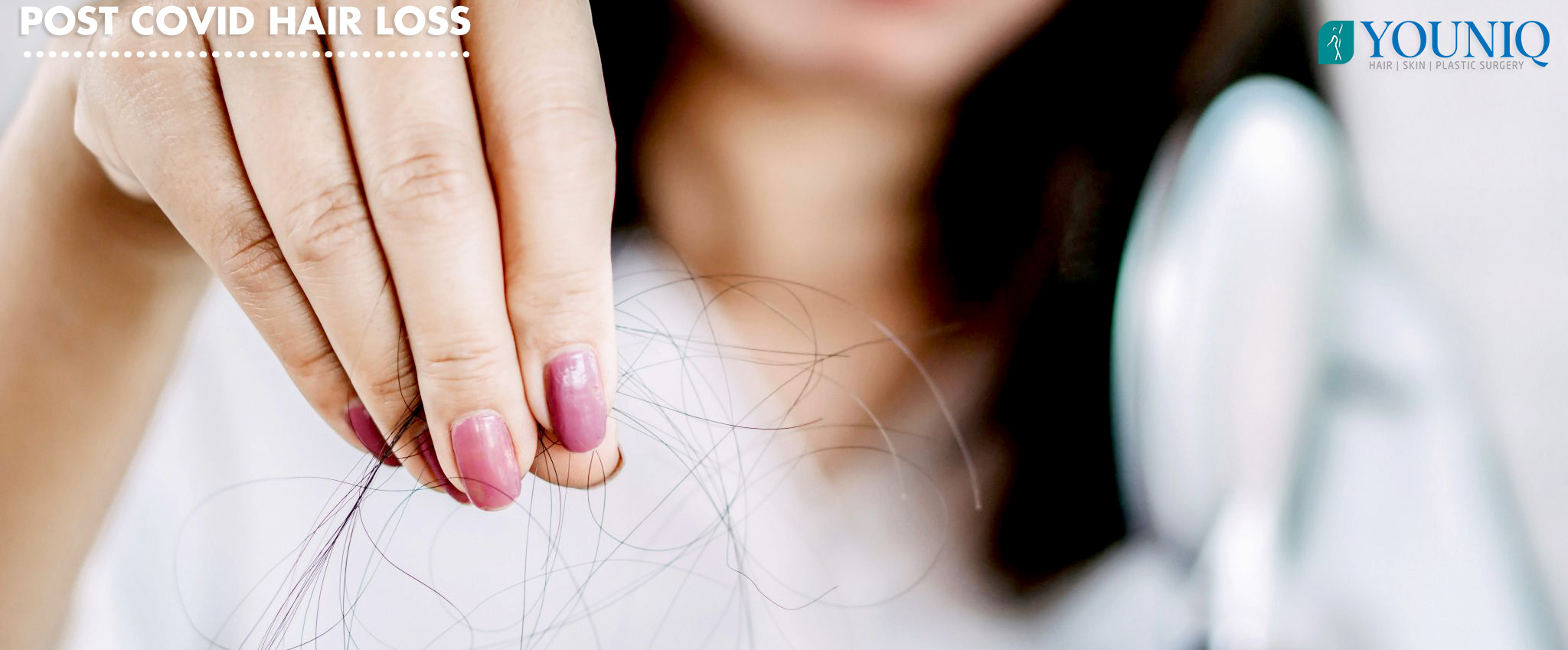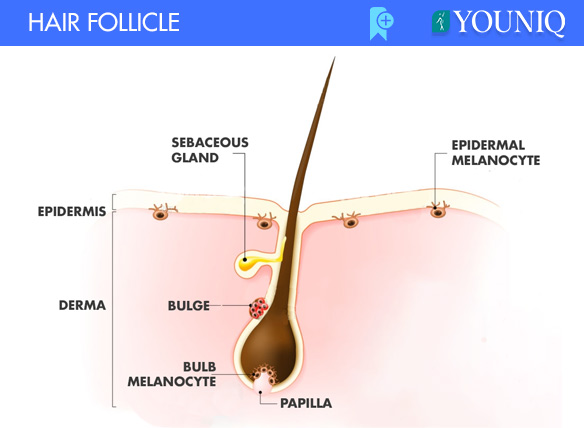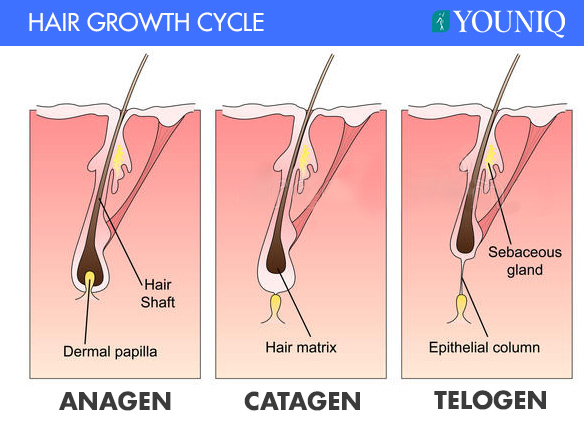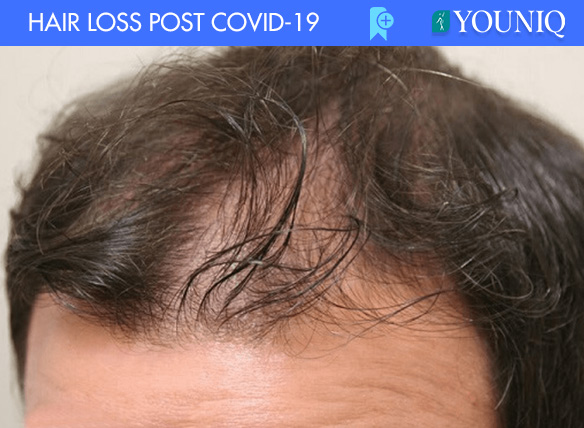

Post Covid Hair Loss
Covid-19 has been quite stressful for the entire world and we entered 2021 with a hope for a better tomorrow.
Hair Loss has been registered as one of the many symptoms during and post Covid infection, so when you are infected with the virus your body starts to fight back and your immune system takes up a major role in fighting the virus when your body undergoes through stress your hair enters a shock phase. In about 8-12 weeks all these ‘Shocked Hair’ start to fall out, which we call “shock loss” or telogen effluvium, it is due to the stress that Covid-19 places on immune system that survivors are experiencing Hair Loss.
Hair follicles are small, pocket-like holes in our skin. As the name suggests, they grow hair. The average human has about 100,000 hair follicles on the scalp alone. We’ll explore what hair follicles are and how they grow hair.


Anatomy of a Follicle
A hair follicle is a tunnel-shaped structure in the epidermis (outer layer) of the skin. Hair starts growing at the bottom of a hair follicle. The root of the hair is made up of protein cells and is nourished by blood from nearby blood vessels.
As more cells are created, the hair grows out of the skin and reaches the surface. Sebaceous glands near the hair follicles produce oil, which nourishes the hair and skin.
The life of a Follicle
On an average, your hair grows about half an inch each month. Your hair growth rate can be affected by your age, hair type, and your overall health.
Hair follicles aren’t just responsible for how much your hair grows, they also influence what your hair looks like. The shape of your follicle determines how curly your hair is. Circular follicles produce straight hair while oval follicles produce curlier hair.
Hair follicles also play a part in determining the color of your hair, as with the skin, your hair gets its pigment from the presence of melanin. There are two types of melanin: eumelanin and pheomelanin.
Your genes determine whether you have eumelanin or pheomelanin, as well as how much of each pigment you have. An abundance of eumelanin makes hair black, a moderate amount of eumelanin makes hair brown, and very little eumelanin makes hair blonde. Pheomelanin, on the other hand, makes hair red.
This melanin is stored in hair follicle cells, which then determine the color of the hair. Your follicles can lose their ability to produce melanin as you age, which results in the growth of grey or white hair.
If hair is pulled out of the hair follicle, it can regrow. It’s possible that a damaged follicle will stop producing hair. Certain conditions, such as alopecia, can cause follicles to stop producing hair altogether.
HAIR GROWTH CYCLE
Hair grows out of the follicles in cycles. There are three different phases of this cycle:
- Anagen (growth) phase. The hair begins to grow from the root. This phase usually lasts between three and seven years.
- Catagen (transitional) phase. The growth slows down and the follicle shrinks in this phase. This lasts between two and four months.
- Telogen (resting) phase. The old hair falls out and new hair begins to grow from the same hair follicle. This lasts between three and four months.


Recent research has suggested that hair follicles aren’t just “resting”’ during the telogen phase. A lot of cellular activity happens during this phase so that the tissues can regenerate and grow more hair. In other words, the telogen phase is crucial to the formation of healthy hair.
Different follicles go through different phases of the cycle at the same time. Some follicles are in the growth phase while others might be in the resting phase. Some of your hairs might be growing, while others are falling out.
Our hair naturally has a long growth phase called Anagen, at the end of this phase, the hair falls out and is replaced by a new hair.
With over 1,00,000 hair on your head, this cycle is barely noticeable since only 10% of your hair normally enter the telogen phase or fallout stage at a time.


TELOGEN EFFLUVIUM
Telogen effluvium is a temporary, but common form of Hair Loss. A stressful event causes hair follicles to go into the telogen phase prematurely. This causes the hair to thin and fall out.
The hair often falls out in patches on the scalp, but in extreme cases, it can fall out in other places on the body, including on the legs, eyebrows, and pubic region.
The stress could be caused by:
- A physically traumatic event
- Childbirth
- A new medication
- Surgery
- Illness (Covid-19)
- A stressful life change
The shock of the event triggers the change in the hair growth cycle.
Telogen effluvium is usually temporary and doesn’t require treatment. However, it’s best to speak to a doctor if you think you have telogen effluvium, because they’ll need to rule out other causes.
But with shock loss up to 90% of your hair may suddenly enter telogen phase leading to massive hair-fall, this typically happens around 6 weeks after your stressful episode, in this case a Covid-19 infection.
Depending on how sick you were, it can take more than six months before the hair starts to make a complete recovery .
The good news is, that the hair can grow back eventually. Though it may take some time in severe cases, Hair Loss may become permanent, especially if you were already having an on-going Hair Loss problem.
It’s best to see your doctor as soon as you start experiencing excessive shedding, you will have more successful outcome if you get treatment sooner.
Shock Hair Loss can be permanent if the Hair Loss is severe and appropriate treatment not done in timely manner.






Post a comment